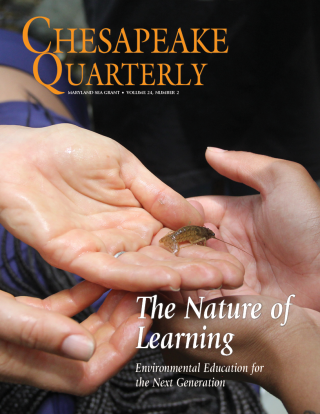Knauss legislative fellowships in Congress help build careers — and they're fun and educational. See our video and fact sheet for details.
The Maryland Sea Grant Bookstore will be closed for the winter holidays from Monday, December 15th to Friday, January 2nd and will not be taking orders during that time.
R/AQ-7
Developing a Technology to Induce Sterility in an Emerging Marine Aquaculture Species, Sablefish, by Disrupting Primordial Germ Cell Development
Principal Investigator:
Ten-Tsao WongStart/End Year:
2016 - 2020Institution:
University of Maryland, Baltimore CountyCo-Principal Investigator:
Yonathan Zohar, University of Maryland, Baltimore County; Adam Luckenbach and William Fairgrieve, NOAA Northwest Fisheries Science CenterTopic(s):
- Aquaculture
Strategic focus area:
Sustainable fisheries and aquacultureDescription:
We have developed a technology to efficiently produce infertile fish by disrupting primordial germ cell development in fish embryos. The technology uses a bath immersion to administer a Morpholino oligomer (MO) against Deadend (Dnd), an essential protein for early germ cell development in fish. This approach has been successfully used in the zebrafish, trout and salmon. The goal of this proposal is to examine the feasibility of applying this technology to sablefish. This goal will be achieved via the following two specific objectives: 1) Identify a suitable sablefish dnd-MO for immersion protocol development; 2) Implement the embryo immersion protocol, evaluate the level of sterility achieved, and optimize treatment conditions to achieve 100% sterility. Sablefish is a high-value species native to the North Pacific. Because of its fast growth rate and high market value, sablefish is considered an excellent marine aquaculture species globally and a rising marine aquaculture species in the U.S. and Canada. Although sablefish can be completely reared in land-based facilities, at present all commercial grow-out operations are in open water using floating net pens. Hence, there is an urgent need to alleviate risks of genetic contamination of wild populations that may cross-breed with cultured escapees. The production and use of reproductively sterile sablefish would be one of the most effective methods to address this concern and promote sustainable and ecologically-responsible aquaculture. Sterile/infertile sablefish that escape aquaculture containment would not be able to reproduce with each other or with wild fish, thereby preventing genetic contamination of wild stocks. If successful, this technology will strengthen the U.S. aquaculture industry by providing reliable and abundant sterile sablefish fingerlings for grow-out production. Indeed, because sterile fish divert little or no energy toward gonadal development, they may exhibit superior growth in aquaculture compared to fertile fish.
Impact/Outcome:
Protecting Native Fish by Developing Methods to Sterilize Farm-Raised Fish
Summary: A Maryland Sea Grant-supported project aims to improve finfish aquaculture by developing a method to systematically raise sterile domestic fish, rendering them incapable of breeding with native fish.
Relevance: The world's human population is projected to reach 8.5 billion by 2030, and aquaculture is a viable way to produce protein to feed that population while also reducing pressures on wild fisheries. In 2016, the United States produced $1.5 billion worth of seafood by aquaculture, much of it oysters ($192 million) and Atlantic salmon ($68 million). A particular problem with aquaculture is the potential for domestically bred fish to escape confinement and possibly breed with wild populations, threatening their very survival. Farmed fish, which are genetically less diverse than native fish, can mate with wild stock and wreak havoc on the gene pool, potentially leading to the displacement or disappearance of native stocks. A method to systematically raise sterile farmed fish that minimizes this threat would benefit local and global aquaculture.
Response: Two researchers at University of Maryland Baltimore County have developed a technology that disrupts the formation of germ cells that would otherwise become an egg and sperm in fish. The scientists use a gene silencer, Morpholino oligomer (MO), to block a key protein called deadend. The team successfully tested the process on zebrafish and have expanded the testing to sablefish, a marine aquaculture species. Building on earlier work that used microinjections for the sterilization, they have developed a "bath" treatment to treat more fish embryos with the sterilization solution simultaneously.
Results: The researchers successfully cloned the sablefish deadend cDNA and applied it to design the MO silencer to use via microinjection and bath immersion. In the first large-scale immersion trial, 10 to 15 percent of the sample were sterile. Protocol parameters are being refined to elevate those numbers; however, the federal shutdown in January 2019 and the COVID-19 pandemic of early 2020 have interfered with access to the broodstocks, located at a NOAA facility in Washington. Thus, the team was unable to repeat the experiment during the optimal months of January through March. They presented their results to wide audiences at Aquaculture America 2020, the World Aquaculture Society's 2019 meeting, and the Korea Federation Fisheries Science and Technology Association conference in 2018.
Related Publications:
Luckenbach, A.; Hayman, E.; Fairgrieve, W.; Wong, T.; Zohar, Y.; Huynh, T.B.. 2020. Investigation of Approaches for Reproductive Sterilization of Sablefish World Aquaculture51(2):56 -57. UM-SG-RS-2020-26.





